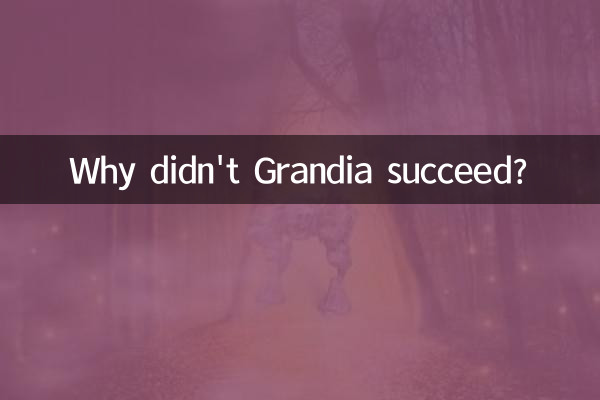Why didn't Grandia succeed?
Among the hot topics on the Internet in the past 10 days, the nostalgia trend in the game industry has once again set off, especially the discussion about classic JRPG (Japanese role-playing game). Among them, the "Grandia" series, as a well-known work from the late 1990s to the early 2000s, has been mentioned by many players. However, compared with series such as "Final Fantasy" and "Dragon Quest" in the same period, "Grandia" did not achieve the same level of commercial success. This article will analyze the reasons why "Grandia" failed to succeed from the perspectives of market performance, game design, distribution strategy, etc., combined with structured data.
1. Comparison of market performance

The following is the comparative data of the market performance of "Grandia" and JRPG in the same period:
| Game name | First year | Global sales (10,000 copies) | Metacritic |
|---|---|---|---|
| Grandia (original generation) | 1997 | about 90 | 82 |
| Final Fantasy VII | 1997 | About 1100 | 92 |
| Dragon Quest VII | 2000 | about 420 | 81 |
It can be seen from the data that the sales volume of "Grandia" is significantly different from that of the leading JRPG. Although its reputation is acceptable, it failed to form sufficient influence.
2. Limitations of game design
Although "Grandia" has some innovations in the combat system (such as timeline turn-based system) and plot presentation, it still has the following problems:
1.Insufficient technical skills: The performance of the Sega SS platform launched in the first generation was limited, and the picture performance was crushed by "Final Fantasy VII" on the PS platform at the same time.
2.Poor IP continuity: Although the sequel "Grandia II" is released on DC/PS2, the plot is not related to the previous game, making it difficult to cultivate loyal fans.
3.Audience positioning is unclear: The European and American market promotion focuses on the "sense of adventure", but the actual gameplay is more traditional JRPG, leading to confusion among target users.
3. Mistakes in issuance strategy
| key decisions | influence |
|---|---|
| The first generation was exclusive to Sega SS | Missing out on PS’s larger user base |
| The sequel’s cross-platform release was too late | After the sales of the DC version were sluggish, the PS2 version was released one year later. |
| European and American localization delays | The first generation European and American version was 2 years later than the Japanese version, so it has passed its popularity. |
4. Summary: Superposition of Multiple Factors
The failure of "Grandia" was not caused by a single reason, but the comprehensive result of multiple problems such as technology, design, and distribution:
-Born at the wrong time: Faced with the phenomenal explosion of "Final Fantasy VII" head-on, resources and attention were squeezed.
-Platform selection error: The failure of the Sega SS dragged down the sales base of the first generation.
-IP operation shortsightedness: Lack of long-term planning, the sequel failed to continue the advantages of the first generation.
Although "Grandia" is still missed by core players today, its commercial failure has also provided a valuable lesson for the industry: on the JRPG track, innovation and sincerity alone are not enough. Accurate market judgment and continuous IP operation are equally critical.

check the details

check the details